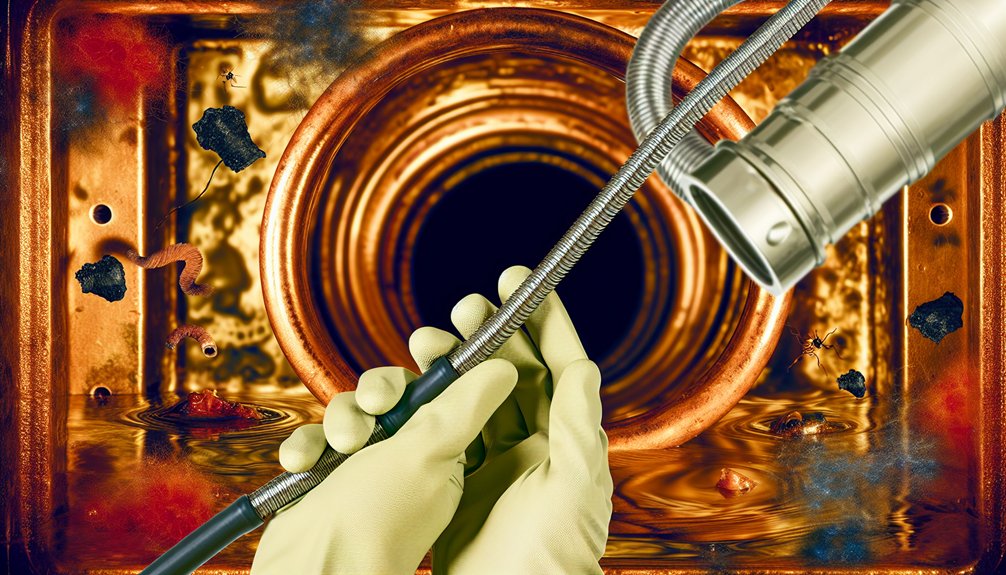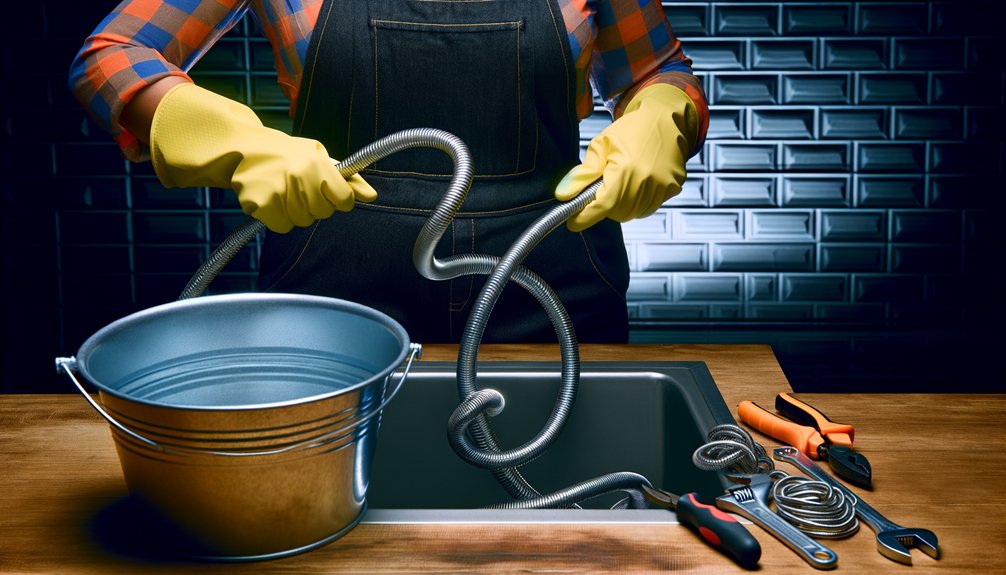Clearing drain blockages independently is a practical approach that saves costs and time. Common clogs are caused by hair, grease, and foreign objects. Essential tools include a plunger, drain snake, and a mixture of baking soda and vinegar. Step-by-step techniques involve removing debris, using boiling water, and employing a plunger for suction. This empowers homeowners with valuable skills and promotes ongoing maintenance. Further insights on effective techniques and essential maintenance tips follow.
Understanding Common Causes of Drain Blockages

Drain blockages are a prevalent issue that can disrupt household plumbing systems and lead to costly repairs if not addressed promptly. Common causes of these blockages include hair and soap scum accumulation in bathroom drains, which can greatly impede water flow when not regularly managed. In kitchen sinks, clogs often arise from grease and food particles; as a result, it is vital to prevent the disposal of fats down the drain and to correctly discard food scraps. Outdoor drains are susceptible to blockages caused by leaves, dirt, and seasonal debris, necessitating routine cleaning to avert severe clogs. Additionally, foreign objects such as toys and toiletries can create considerable disruptions, underscoring the importance of proper disposal methods. Finally, mineral buildup from hard water, particularly calcium, can constrict pipes over time, highlighting the necessity for ongoing maintenance to guarantee ideal drainage functionality.
Essential Tools and Materials for DIY Drain Cleaning
Effective drain cleaning requires a selection of essential tools and materials that facilitate the removal of blockages. Utilizing the right equipment enhances the effectiveness of DIY drain cleaning efforts and promotes long-term maintenance.
| Tool/Material | Purpose | Benefits |
|---|---|---|
| Plunger | Creates suction to dislodge clogs in sinks/toilets | Quick and effective for minor blockages |
| Drain Snake | Reaches deeper clogs in pipes | Effective for stubborn blockages |
| Baking Soda & Vinegar | Natural fizzing reaction for minor clogs | Dissolves clogs and deodorizes drains |
| Boiling Water | Softens grease and dissolves blockages | Simple yet powerful method |
| Wet/Dry Vacuum | Provides suction to remove debris | Versatile for various clog situations |
With these essential tools, individuals can effectively tackle various blockages, prevent future issues, and maintain a clean drainage system.
Step-by-Step Techniques for Clearing Clogged Drains

A systematic approach to clearing clogged drains can considerably enhance the likelihood of successful blockage removal. Initially, one should remove visible debris from the drain using gloves and appropriate tools, preventing further issues. Next, pouring boiling water in stages helps dissolve grease and soap scum, although care must be taken with PVC pipes. Following this, employing a plunger is essential; it should be positioned to create a tight seal around the drain to generate adequate suction and pressure. For deeper clogs, a drain snake is effective; turning the handle allows it to break up stubborn blockages. Additionally, a DIY drain remedy involving baking soda and vinegar can be utilized to create a fizzing reaction, aiding in dislodging minor clogs. By systematically following these techniques, one can efficiently clear the drain and eliminate standing water, restoring ideal function to the plumbing system.
Frequently Asked Questions
How Do You Unclog a Drain Step by Step?
In an era where plumbing tools are as essential as the wheel, unclogging drains necessitates a systematic approach. First, assess the kitchen sink or bathroom drain for visible debris. Employ natural remedies, like baking soda and vinegar, to initiate the process. If toilet blockages persist, utilize a plunger to restore water flow. For deeper clogs in drainage systems, a drain snake is crucial. As a last resort, consider chemical cleaners or professional help. Preventive measures can mitigate future issues.
Why Should You Never Use Baking Soda and Vinegar to Unclog a Drain?
The reliance on baking soda and vinegar for unclogging drains is rooted in drain cleaning myths. While marketed as natural remedies, their limited effectiveness often leads to persistent clogs, necessitating professional intervention. DIY plumbing enthusiasts may overlook essential plumbing tips, such as proper pipe maintenance. Additionally, these methods can inadvertently contribute to environmental impact, as they fail to address deeper issues. For effective clog prevention and resolution, alternative solutions, including chemical drain cleaners or plumber's snakes, are advisable.
How to Unblock a Severely Blocked Drain?
To unblock a severely blocked drain, one should employ effective drain cleaning techniques. Start by identifying common causes and utilizing plumbing tools such as plungers and drain snakes. Safety precautions are critical when handling debris. If DIY methods fail, professional help may be necessary, using advanced tools like hydro jets and drain inspection cameras. Consider the environmental impact of chosen methods, and guarantee regular maintenance tips are followed based on pipe materials to prevent future issues.
What Is the Primary Step to Unclog Any Blockage in the Pipes?
To address pipe blockages effectively, one must first identify the common causes hindering water flow, such as hair or grease. This initial step contrasts sharply with the reliance on plumbing services, emphasizing DIY solutions. Utilizing plumbing tools, such as plungers and snakes, coupled with drain maintenance practices, enhances clog prevention. Implementing household remedies, alongside thorough pipe inspection, fosters a proactive approach in maintaining drainage systems and ensuring lasting functionality.



